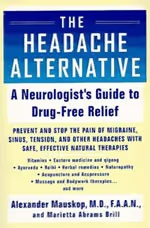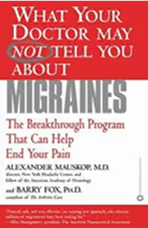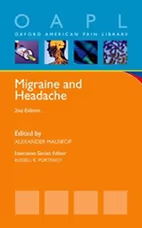Alternative therapies for children
NATIONAL HEADACHE FOUNDATION
NHF Headlines, Winter, 2011
(The contents have been modified and updated from the original publication)
Kids KORNER
Complementary and Alternative Therapies
By Alexander Mauskop, MD, FAAN,
Director of the New York Headache Center, New York NY
(You may also want to read this article on headaches in children elsewhere on our site)
Parents of kids with headaches frequently ask about complementary and alternative approaches, hoping to avoid prescription medications and their associated side effects. As it turns out scientific studies have shown that many of these alternative treatments can be beneficial in reducing headaches, with very few side effects. Taking these factors into account, the treatments described below are worth trying by most, if not all, headache sufferers. However, before considering any kind of medication, whether conventional or alternative the first step is to make sure that the child has healthy habits. Parents and children, especially adolescents, should be counseled about the importance of regular and nutritious meals without any caffeine, chocolate or other known dietary migraine triggers. Frequent exercise and regular sleeping patterns are also important factors in decreasing headaches.
Stress is a major contributor to headaches, even in young children. One of the best treatments for migraine and tension-type headaches is biofeedback. Many studies have shown that biofeedback works well, with long-lasting benefits. However similar and less expensive techniques such as self-taught progressive relaxation and meditation, work equally well. The advantage of biofeedback is that a biofeedback therapist can make the learning process easier and can act as a coach and motivator.
Supplements for Headache Prevention
Magnesium deficiency is a common contributor and, in some cases, the main cause of migraine and cluster headaches. Daily magnesium supplementation can be effective in preventing headaches although oral supplementation does not help a small minority of magnesium-deficient patients who have poor absorption. These latter patients usually respond well to an intravenous infusion of magnesium. The recommended daily dose of magnesium is 400 mg. for adults and children weighing more than 90 lbs. Magnesium should always be taken with food, otherwise it can cause diarrhea and stomach pains. If one type of magnesium causes these side effects even when taken with food, another type should be tried. Magnesium glycinate and other forms of chelated magnesium tend to be better absorbed.
Co-enzyme Q10 (CoQ10) is an ingredient present in each cell of our bodies and was found to be deficient in one third of children with migraines. Taking 300 mg of CoQ10 daily can prevent migraine headaches in adolescents who are deficient. A proportionally smaller dose is given to younger children.
Feverfew is an herb that has been in use for the treatment of headaches for 100 years. It is very safe except in those suffering from pollen and other allergies because they could also be allergic to feverfew. The dose of feverfew varies depending on the manufacturer.
Butterbur, unlike feverfew, is an herb that has to be purified to be safe for consumption. Butterbur products made by the German company Weber & Weber and sold under several brand names are considered safe. The usual dose for adolescents is 150 mg daily.
Boswellia is a very safe herb which has anti-inflammatory properties and is usually promoted for joint mobility. However, inflammation is present during migraine attacks, as well as in cluster headaches and hemicrania continua.
Non-Drug Therapies
Acupuncture was studied in dozens of clinical trials and proven to relieve migraine and tension-type headaches. While patients frequently express concern about discomfort from acupuncture needles, treatment is usually not painful. Some people experience an immediate effect, but more often, weekly sessions are needed before beneficial effects are seen. A typical course is at least 10 weekly sessions.
Botox does not belong to the group of alternative therapies, but nevertheless it is a safer treatment than drugs. Botox injections were just approved by the FDA for the treatment of chronic migraines in adults. Chronic migraine, which is defined as headaches occurring on l5 or more days each month, affects more than 3 million Americans. In the past 15 years of using Botox, I have treated many children with chronic headaches aged l0 and older with excellent results. The main drawback of Botox is its cost, but, with the recent FDA approval, more insurance companies will be compelled to cover it.
Addendum:
Since this article was published we have discovered that the butterbur product made in Germany is no longer allowed to be sold there because the company changed its purification process and did not repeat all of the required safety studies. Butterbur made in Germany and in the US is still sold in the US, but our FDA does not regulate herbal products and does not require the extensive safety tests that are required in Germany. We no longer recommend butterbur for our patients, children or adults.
.jpg)



This “book” appears to have largely been born out of his blog from the New York Headache Center. For years, he has regularly put up information, scientific and clinical, for his headache followers. He has created this “book,” actually an e-book, which takes relevant information from his experience and knowledge of migraine. There is no need for an index and chapter references. He uses hyperlinks, embedded in the e-book, to connect to material online, which he puts in context for the reader. This works very well as one hyperlink may go to an original paper or publication or a resource site.
He links to major medical journals including headache journals and his own publications, when helpful, as well as nonmedical literature and other sites. This format allows the e-book to be updated from time to time, which is easy to do with this approach.
The book has a very interesting introduction and deals with evidence-based medicine and its role in migraine therapy. When he begins the section on 150+ treatments, he starts with a very interesting comment. Many of the treatment ideas that I describe in this book are not just off-label (that is, not approved by the FDA) but may appear to be off-the-wall. It is refreshing to hear such intellectual honesty from a practicing neurologist.
There is a great section on supplements and finding someone to help with your migraine, such as coach, a partner, or a sympathetic friend. A diagnostic discussion follows and is most helpful, as proper diagnosis directs treatment, as are the detailed sections on triggers including environment, food, exercise, physical therapies, and sleep. Herbal therapies are covered as is neuromodulation and injections/blocks among others.
In the sections on drugs, he deals with acute therapies and the modern use of triptans and gepants, and a ditan. Preventive therapies start with monoclonal calcitonin gene-related peptide antibodies, tricyclic medications, and many other preventive therapies including beta blockers, anti-seizure drugs, nonsteroidal anti-inflammatory drugs, and botulinum injections. From acupuncture to Feldenkrais methods, he covers the contemporary plethora of migraine “treatments” as he sees it in practice.
He ranks all medications on a 1 to 10 scale regarding his own subjective opinions of the utility of each treatment. He indicates that no treatment gets 10 as a score and any receiving a score of 1 were not rated. He also lists his favorite migraine therapies separately. He includes a lot of data links here, from single case reports to full-scale randomized clinical trials, and detailed reviews. His clinical acumen shines through the volume and one gets the impression that this is a very personal view at times, not always backed by evidence, as there may not be any, but by experience, practice and pragmatism. He carefully notes the general things to be careful of in taking some treatments and warns if there are serious concerns. Nonetheless, he indicates clearly that the advice of a medical professional should be sought before trying the therapies mentioned.
Diagnosing secondary headache that can mimic migraine or vice versa is a useful section but does not go into depth about the disorders/diseases mentioned, as this is not the intention of the book. Special circumstances are given sections including menstrual migraine, pregnancy, resistant/refractory headache, aura and headache, and many others.
The author is a senior, highly experienced neurologist and has a high degree of interest in migraine and other headache disorders. He has a sense of curiosity about the brain and migraine and that comes through to the reader of this small volume. I count 23 endorsements, including the excellent foreward of the book from a wide range of well-known people, which includes two prior editors of this journal. He is well liked and highly respected by his colleagues.
In many ways, this book does what online databases on diseases cannot do most times. He tells the reader what he knows and how to use that knowledge. He directs the novice and experts to the right literature and takes the reader on a personal journey through the field of migraine treatments. He tells people, “…keep seeking relief, not to give up on or blame yourself for the pain you experience from migraine.”
There is a printed version of the book; however, the e-book is ideal for the intended purpose. I would recommend it the first instance. It is available via a commercial site and inexpensive.
I would recommend this book to anyone who has migraine or cares for people with migraine and wants a broad and sometimes detailed overview of the treatments. Available in the e-book format, it represents a lot of work for one person, but his passion, occasional humor, and historical perspectives are evident in this work. You don’t have to agree or accept everything the author says to enjoy and benefit from this “book,” and I know he would want people to be critical and skeptical where warranted. However, you will find more than you would usually need to know from this banquet of 150 ways to help your migraines! Enjoy, I did very much. Read it through once and save as reference.
Alexander Mauskop, Director of the New York Headache Center, and Marietta Abrams Brill, a freelance medical writer, have written principally for headache sufferers in North America. They answer questions like “is Rolfing covered by medical insurance?”, and include an excellent resource section in the back. of the book which lists American organizations for the various therapies. But they provide enough background information on both headache and alternative treatments to make their book interesting to readers from other countries, too. In covering most of the more common alternative therapies~like herbs, acupuncture, massage, Ayuverda and Eastern medicine, and qigong-they aim to inform rather than judge, cite research evidence where it exists, and point to potential dangers as well as benefits.
Each of the 10 chapters is introduced with a pithy quote: “Divine is the work to subdue pain” (Hippocrates) heads the first chapter. After general background on pain theories and headache diagnosis, common alternative approaches are covered in turn and there is, of course, oodles of advice on diet and nutrition. A helpful glossary guides readers through words that conventional doctors are familiar with, like Scotoma, and those with which we aren’t, like Qi, Vatta, and Pitta. To round off, a comprehensive resource section and selected bibliography give useful directions to readers wanting more information about specific therapies.
Like all good guides, this one follows a logical structure and so it is relatively simple to go quickly to the information you want to find. It is easy to read. All in all, it is a guide which headache sufferers looking for good information on alternative therapies can be thankful for.
